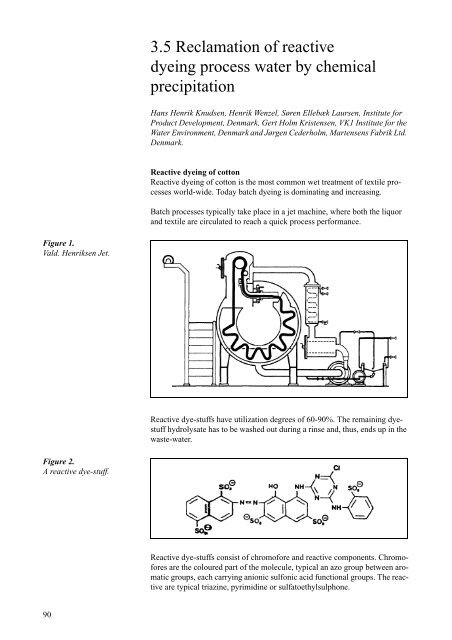Cleaner Technology Transfer to the Polish Textile ... - Miljøstyrelsen
Cleaner Technology Transfer to the Polish Textile ... - Miljøstyrelsen
Cleaner Technology Transfer to the Polish Textile ... - Miljøstyrelsen
You also want an ePaper? Increase the reach of your titles
YUMPU automatically turns print PDFs into web optimized ePapers that Google loves.
Figure 1.<br />
Vald. Henriksen Jet.<br />
Figure 2.<br />
A reactive dye-stuff.<br />
90<br />
3.5 Reclamation of reactive<br />
dyeing process water by chemical<br />
precipitation<br />
Hans Henrik Knudsen, Henrik Wenzel, Søren Ellebæk Laursen, Institute for<br />
Product Development, Denmark, Gert Holm Kristensen, VK1 Institute for <strong>the</strong><br />
Water Environment, Denmark and Jørgen Cederholm, Martensens Fabrik Ltd.<br />
Denmark.<br />
Reactive dyeing of cot<strong>to</strong>n<br />
Reactive dyeing of cot<strong>to</strong>n is <strong>the</strong> most common wet treatment of textile processes<br />
world-wide. Today batch dyeing is dominating and increasing.<br />
Batch processes typically take place in a jet machine, where both <strong>the</strong> liquor<br />
and textile are circulated <strong>to</strong> reach a quick process performance.<br />
Reactive dye-stuffs have utilization degrees of 60-90%. The remaining dyestuff<br />
hydrolysate has <strong>to</strong> be washed out during a rinse and, thus, ends up in <strong>the</strong><br />
waste-water.<br />
Reactive dye-stuffs consist of chromofore and reactive components. Chromofores<br />
are <strong>the</strong> coloured part of <strong>the</strong> molecule, typical an azo group between aromatic<br />
groups, each carrying anionic sulfonic acid functional groups. The reactive<br />
are typical triazine, pyrimidine or sulfa<strong>to</strong>ethylsulphone.

















